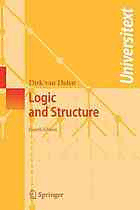Table Of ContentDirk van Dalen
Logic
and Structure
Fourth Edition
ABC
DirkvanDalen
DepartmentofPhilosophy
UtrechtUniversity
Heidelberglaan8
P.O.Box80126
3508TCUtrecht
TheNetherlands
dirk.vandalen@phil.uu.nl
Corrected2ndprinting2008
ISBN978-3-540-20879-2
LibraryofCongressControlNumber:2008929906
MathematicsSubjectClassification(2000):03-01(textbook);03B15,03F05,03C07
(cid:1)c 2004,1994,1983,1980Springer-VerlagBerlinHeidelberg
Thisworkissubjecttocopyright.Allrightsarereserved,whetherthewholeorpartofthematerial
isconcerned,specificallytherightsoftranslation,reprinting,reuseofillustrations,recitation,broad-
casting,reproductiononmicrofilmorinanyotherway,andstorageindatabanks.Duplicationof
thispublicationorpartsthereofispermittedonlyundertheprovisionsoftheGermanCopyrightLaw
ofSeptember9,1965,initscurrentversion,andpermissionforusemustalwaysbeobtainedfrom
Springer.ViolationsareliabletoprosecutionundertheGermanCopyrightLaw.
Theuseofgeneraldescriptivenames,registerednames,trademarks,etc.inthispublicationdoesnot
imply,evenintheabsenceofaspecificstatement,thatsuchnamesareexemptfromtherelevantpro-
tectivelawsandregulationsandthereforefreeforgeneraluse.
Coverdesign:ErichKirchner,Heidelberg
Printedonacid-freepaper
987654321
springer.com
Preface
Logic appears in a ‘sacred’ and in a ‘profane’ form; the sacred form is domi-
nant in proof theory, the profane form in model theory. The phenomenon is
not unfamiliar, one observes this dichotomy also in other areas, e.g. set the-
ory and recursion theory. Some early catastrophies, such as the discovery of
the set theoretical paradoxes (Cantor, Russell), or the definability paradoxes
(Richard, Berry), make us treat a subject for some time with the utmost
awe and diffidence. Sooner or later, however, people start to treat the mat-
ter in a more free and easy way. Being raised in the ‘sacred’ tradition, my
firstencounter with the profane traditionwassomething like a culture shock.
HartleyRogersintroducedmetoamorerelaxedworldoflogicbyhisexample
of teaching recursion theory to mathematicians as if it were just an ordinary
coursein,say,linearalgebraoralgebraictopology.InthecourseoftimeIhave
cometoacceptthis viewpointasthe didacticallysoundone:beforegoinginto
esoteric niceties one should develop a certain feeling for the subject and ob-
tain a reasonable amount of plain working knowledge. For this reason this
introductory text sets out in the profane vein and tends towards the sacred
only at the end.
The present book has developed out of courses given at the mathematics
department of Utrecht University. The experience drawn from these courses
and the reaction of the participants suggested strongly that one should not
practiceandteachlogicinisolation.Assoonaspossibleexamplesfromevery-
day mathematics should be introduced; indeed, first-order logic finds a rich
field of applications in the study of groups, rings, partially ordered sets, etc.
Theroleoflogicinmathematicsandcomputerscienceistwo-fold—atool
forapplicationsinbothareas,andatechniqueforlayingthefoundations.The
latter role will be neglected here, we will concentrate on the daily matters of
formalised (or formalizable) science. Indeed, I have opted for a practical ap-
proach,—I willcoverthe basics ofprooftechniques andsemantics,andthen
go on to topics that are less abstract. Experience has taught us that the nat-
ural deduction technique of Gentzen lends itself best to an introduction, it is
close enough to actual informal reasoning to enable students to devise proofs
VI Preface
by themselves. Hardly any artificial tricks are involved and at the end there
is the pleasing discovery that the system has striking structural properties,
in particular it perfectly suits the constructive interpretation of logic and it
allowsnormalforms.Thelattertopichasbeenaddedtothiseditioninviewof
its importance in theoretical computer science. In chapter 3 we already have
enough technical power to obtain some of the traditional and (even today)
surprising model theoretic results.
The book is written for beginners without knowledge of more advanced
topics, no esoteric set theory or recursion theory is required. The basic in-
gredients are natural deduction and semantics, the latter is presented in con-
structive and classical form.
Inchapter5intuitionisticlogicistreatedonthebasisofnaturaldeduction
withouttheruleofReductioadabsurdum,andofKripkesemantics.Intuition-
istic logic has gradually freed itself from the image of eccentricity and now it
is recognisedfor its usefulness ine.g., topos theory andtype theory,hence its
inclusioninaintroductorytextisfullyjustified.Thefinalchapter,onnormali-
sation,hasbeenaddedforthesamereasons;normalisationplaysanimportant
roleincertainpartsofcomputerscience;traditionallynormalisation(andcut
elimination) belong to proof theory,but gradually applications in other areas
have been introduced. In chapter 6 we consider only weak normalisation, a
number of easy applications is given.
Various people have contributed to the shaping of the text at one time
or another; Dana Scott, Jane Bridge, Henk Barendregt and Jeff Zucker have
been most helpful for the preparation of the first edition. Since then many
colleagues and students have spotted mistakes and suggested improvements;
thiseditionbenefitedfromtheremarksofEleanorMcDonnell,A.Scedrovand
Karst Koymans. To all of these critics and advisers I am grateful.
Progress has dictated that the traditional typewriter should be replaced
bymoremoderndevices;thisbookhasbeenredoneinLATEXbyAddieDekker
and my wife Doke. Addie led the way with the first three sections of chap-
ter one and Doke finished the rest of the manuscript; I am indebted to both
of them, especially to Doke who found time and courage to master the se-
crets of the LATEX trade. Thanks go to Leen Kievit for putting together the
derivations and for adding the finer touches requiredfor a LATEX manuscript.
Paul Taylor’s macro for proof trees has been used for the natural deduction
derivations.
June 1994 Dirk van Dalen
TheconversiontoTEXhasintroducedanumberoftyposthatarecorrected
inthe presentnew printing.Manyreadershavebeen sokindto sendmetheir
collectionofmisprints,Iamgratefultothemfortheirhelp.InparticularIwant
to thank Jan Smith, Vincenzo Scianna, A. Ursini, Mohammad Ardeshir, and
Norihiro Kamide. Here in Utrecht my logic classes have been very helpful; in
particular Marko Hollenberg, who taught part of a course, has provided me
Preface VII
with useful comments. Thanks go to them too.
I have used the occasion to incorporate a few improvements. The definition
of ‘subformula’ has been streamlined – together with the notion of positive
andnegativeoccurrence.Thereisalsoasmalladdendumon‘inductiononthe
rank of a formula’.
January 1997 Dirk van Dalen
Atthe requestofusersIhaveaddedachapteronthe incompletenessofarith-
metic.Itmakesthe book moreself-contained,andaddsuseful informationon
basicrecursiontheoryandarithmetic.Thecodingofformalarithmeticmakes
use of the exponential; this is not the most efficient coding, but for the heart
ofthe argumentthatis notofthe utmostimportance.Inorderto avoidextra
work the formal system of arithmetic contains the exponential. As the proof
technique of the book is that of natural deduction, the coding of the notion
ofderivabilityisalsobasedonit.Thereareofcoursemanyother approaches.
The reader is encouraged to consult the literature.
ThematerialofthischapterisbyandlargethatofacoursegiveninUtrecht
in1993.Students havebeenmosthelpful incommenting onthe presentation,
and in preparing TEX versions. W. Dean has kindly pointed out some more
corrections in the old text.
The final text has benefited from comments and criticism of a number
of colleagues and students. I am grateful for the advice of Lev Beklemishev,
JohnKuiper,CraigSmoryn´ski,andAlbertVisser.Thanks aredue to Xander
Schrijen, whose valuable assistance helped to overcome the TEX-problems.
May 2003 Dirk van Dalen
A number of corrections has been provided by Tony Hurkens; furthermore, I
am indebted to him and Harold Hodes for pointing out that the definition of
“free for” was in need of improvement. Sjoerd Zwartfound a nasty typo that
had escaped me and all (or most) readers.
April 2008 Dirk van Dalen

